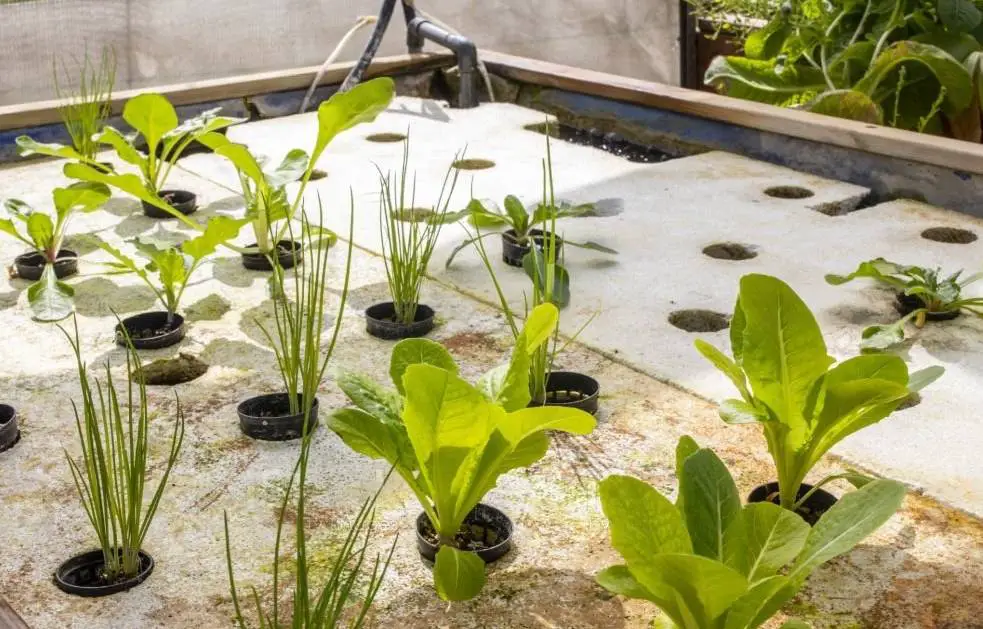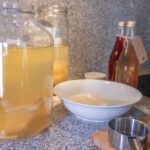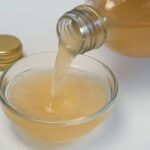Are you curious about aquaponics, the innovative farming method that’s taking sustainability to new heights? Aquaponics combines fish farming and plant production for an ultra-efficient growing system.
In this blog post, we’ll explore interesting facts about aquaponics: from how it works to its benefits and challenges. Stay tuned to dive into the world of symbiotic systems that could revolutionize your food growth!
Key Takeaways
- Aquaponics combines fish farming and plant production for a sustainable growing system that produces more crops in less space compared to traditional agriculture.
- This innovative method utilizes nutrient – rich water from the fish to fertilize plants, creating a symbiotic ecosystem where the plants help purify the water for the fish.
- Aquaponics is environmentally friendly and reduces water usage by recycling water through a closed-loop system. It also eliminates the need for synthetic fertilizers, promoting organic farming practices.
- Challenges in aquaponics include maintaining proper nutrient levels and implementing effective pest control strategies while ensuring sufficient oxygenation through air pumps.

Aquaponics Farming Facts
Aquaponics farming produces more crops in less space compared to traditional agriculture and utilizes nutrient-rich water from fish to fertilize plants, creating a symbiotic ecosystem where the plants help purify the water for the fish.
Produces more crops in less space compared to traditional agriculture
Aquaponics is a champ at making the most out of small spaces. It grows up to 10 times more crops than regular farms in the same space. This is great for places where land is not plenty, like cities.
Even a tiny area can turn into a lush garden with aquaponics. The secret lies in its clever use of water and nutrients shared between fish and plants. Farmers love it because they get lots of produce without needing vast fields.
Utilizes nutrient-rich water from fish to fertilize plants
Aquaponics is a unique farming method that takes advantage of the nutrient-rich water produced by fish to fertilize plants. In this system, the waste products from the fish are broken down by beneficial bacteria into useful nutrients for the plants.
Instead of using synthetic fertilizers, aquaponics uses this natural process to nourish the crops. This not only reduces the need for harmful chemicals but also creates a sustainable and environmentally friendly growing environment.
The plants, in turn, help purify the water by absorbing these nutrients, creating a symbiotic relationship between fish and plants in an aquaponics system.
Plants help purify the water for the fish
In aquaponics, plants play a crucial role in purifying the water for the fish. As the fish produce waste, it accumulates in the water and can be harmful to their health if not removed.
However, the plants act as natural filters by absorbing these waste products as nutrients for their growth. Through a process called biofiltration, the plants take up nitrogen compounds from the fish waste and convert them into forms that are less toxic.
This helps maintain a clean and healthy environment for both the plants and fish in an aquaponics system without needing additional filtration systems or chemicals.
Benefits of Aquaponics
Aquaponics is a sustainable and environmentally friendly method of food production that reduces water usage and eliminates the need for synthetic fertilizers.
Sustainable and environmentally friendly
Aquaponics is a sustainable and environmentally friendly method of farming. By using a closed-loop system, it reduces the need for synthetic fertilizers and pesticides, making it an organic farming option.
Aquaponics also promotes water conservation as it recirculates water between the fish tank and plant beds. This means less water is used compared to traditional agriculture methods.
Additionally, aquaponics creates an ecological balance by utilizing nutrient-rich fish waste to nourish the plants, which in turn purify the water for the fish. With its ability to produce food in urban environments through vertical or greenhouse farming, aquaponics offers a sustainable solution to address food security concerns while minimizing negative environmental impacts.
Reduces water usage
Aquaponics is an innovative farming method that helps reduce water usage. Aquaponics uses a closed-loop system where the water is continuously recycled which makes this a sustainable agriculture.
The fish waste in the system provides nutrients for the plants, and as the plants take up these nutrients, they help purify the water for the fish. This means that aquaponics can produce food using significantly less water compared to conventional farming methods.
In fact, studies have shown that aquaponics can use 90% less water than traditional soil-based agriculture while still producing abundant crops. By reducing water usage, aquaponics offers a sustainable solution for food production that conserves this precious resource.
Reduces the need for synthetic fertilizers
Aquaponics is a farming method that reduces the need for synthetic fertilizers. In this system, fish waste provides natural nutrients to the plants, acting as a fertilizer. The plants then absorb these nutrients and purify the water for the fish.
This closed-loop system eliminates the need for chemical fertilizers typically used in traditional agriculture, making aquaponics an environmentally friendly alternative. By reducing reliance on synthetic fertilizers, aquaponics promotes organic farming practices and helps to protect our ecosystems from harmful chemicals.
Interesting Facts about Aquaponics Systems

Aquaponics systems combine aquaculture and hydroponics, creating a unique and sustainable method of food production. Want to learn more about this fascinating system? Keep reading!
Combines aquaculture and hydroponics
Aquaponics is a unique farming method that combines aquaculture and hydroponics. In aquaculture, fish are raised in tanks or ponds, while hydroponics involves growing plants without soil using nutrient-rich water.
In an aquaponic system, the waste produced by the fish serves as fertilizer for the plants. The plants then help to purify the water for the fish by absorbing these nutrients. This symbiotic relationship between fish and plants creates a closed-loop ecosystem where both thrive together.
As a result, aquaponics allows for organic and fresh produce to be grown in a sustainable and environmentally friendly way.
Creates a symbiotic ecosystem
Aquaponics creates a symbiotic ecosystem where plants and fish work together to thrive. In this system, the waste produced by the fish serves as a natural fertilizer for the plants.
As the plants absorb nutrients from the water, they help purify it by removing toxins that could harm the fish. This mutual relationship allows both plants and fish to grow in a healthier environment without using synthetic fertilizers or harmful chemicals.
This symbiotic interaction is crucial for maintaining an ecological balance within aquaponics systems. The fish provide food for the plants through their waste, while the plants filter and clean the water for the fish.
It’s like a continuous cycle where each element relies on and supports one another. This closed-loop system not only promotes sustainable agriculture but also conserves water since it can be reused instead of being wasted.
Provides organic and fresh produce
Aquaponics is a farming method that not only produces crops, but also provides organic and fresh produce. In aquaponics systems, plants grow in nutrient-rich water that comes from the fish tanks.
This water acts as a natural fertilizer for the plants, ensuring they receive all the necessary nutrients to grow and thrive. As a result, the produce grown in aquaponics systems is organic and free from synthetic fertilizers or pesticides.
This means you can enjoy fresh vegetables and herbs straight from your own aquaponics garden without worrying about harmful chemicals.
Challenges of Aquaponics

Maintaining proper nutrient levels can be a challenge in aquaponics as it requires careful monitoring and adjustments to ensure the fish and plants receive adequate nutrition.
Maintaining proper nutrient levels
Aquaponics systems rely on a delicate balance of nutrients to ensure optimal plant growth. Nutrient levels need to be carefully monitored to provide the plants with the right amount of food they need.
This involves regularly testing the water for nutrient levels and adjusting them as necessary. If nutrient levels become imbalanced, it can affect plant growth and overall system health.
Aquaponic farmers may use organic supplements or natural additives to maintain proper nutrient levels in their systems. By closely monitoring and managing the nutrients, aquaponics allows for efficient and sustainable food production without relying on synthetic fertilizers.
Pest control
Pests can be a challenge in aquaponics systems. Without proper management, insects and other pests such as aphids or snails can damage the plants and disrupt the delicate balance of the ecosystem.
This requires careful monitoring and proactive measures to prevent infestations. Some common pest control methods used in aquaponics include introducing beneficial predators like ladybugs or using organic sprays made from natural ingredients such as neem oil or garlic extract.
It’s important to find a balance between controlling pests and maintaining the overall health of the system without harming the fish or plants. By implementing effective pest control strategies, aquaponics farmers can ensure healthy plant growth and minimize potential damage caused by pests while still maintaining an organic and sustainable farming approach.
Air pumps are critical for oxygenation
Air pumps play a crucial role in aquaponics systems by ensuring there is enough oxygen for both the plants and fish. These pumps help to circulate air into the water, which allows the plants’ roots to receive the necessary oxygen they need for growth.
Additionally, the fish in the system rely on these air pumps to provide oxygen for their survival. Without proper oxygenation, both the plants and fish can suffer from stress or even die.
Therefore, maintaining and monitoring air pump functionality is essential in order to maintain a healthy and thriving aquaponics system.
Conclusion
Aquaponics is an amazing farming method that combines aquaculture and hydroponics. It produces 10 times more crops in the same space as traditional agriculture. This sustainable system uses fish waste to fertilize plants, creating a natural ecosystem that benefits both the plants and the fish.
With careful monitoring of nutrient levels and pest control, aquaponics can provide fresh produce and fish in urban environments while reducing water usage and synthetic fertilizer reliance.
It’s truly an innovative solution for sustainable food production.
FAQs
1. What is aquaponics?
Aquaponics is a sustainable farming method that combines aquaculture (raising fish) and hydroponics (growing plants in water) in a symbiotic system.
2. How does aquaponics work?
In aquaponics, fish waste provides nutrients for the plants, while the plants filter and clean the water for the fish, creating a natural cycle without the need for soil.
3. What are some benefits of aquaponics?
Some benefits of aquaponics include using less water compared to traditional farming, no need for synthetic fertilizers or pesticides, and being able to grow both vegetables and fish simultaneously.
4. Can I set up an aquaponic system at home?
Yes, it is possible to set up a small-scale aquaponic system at home with proper guidance and equipment. It can be a rewarding way to grow fresh food in your own space.
5. What challenges are associated with aquaponics?
Aquaponics requires careful nutrient balance, effective pest control, and consistent oxygenation using air pumps.
6. How does aquaponics contribute to sustainable agriculture?
Aquaponics conserves water by recycling it in a closed-loop system, eliminates the need for synthetic fertilizers by using fish waste, and maximizes crop yield in limited spaces.

As a dedicated mother and passionate software developer, she weaves her diverse experiences into captivating stories that inspire and engage readers. Emma's love for sustainable living and environmental consciousness permeates both her personal and professional life. When she's not immersed in the world of coding and software development, Emma can be found nurturing her family and tending to her thriving organic garden. Her commitment to sustainable practices extends to every aspect of her life, from repurposing household items to embracing eco-friendly technologies.










